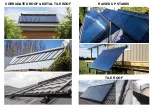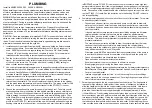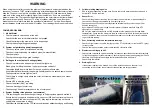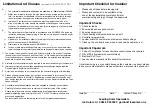
When using the controller to control the element, the element is only activated when the
top sensor is under a THET set point and during a time heating period.Most solar cylinders
have the T3 sensor too high, this should be at the halfway point, if mid element is being
used, and at the same level or slightly higher than the element. If you are controlling a
bottom element, the T3 probe should be slightly above the solar return or bottom element
(whichever is the highest). Do not put T3 at top of cylinder, otherwise you will not guar-
antee the user hot water more than the quantity of water above T3 probe. Ensure good
contact between probe and inner barrel of cylinder. Poor readings result in poor operation
COMMON PROBLEMS:
1. No Hot Water
• Check element is switched on at the wall.
• Check that the fuse in the thermostat has not popped.
• Check the timing for the element is on for long enough.
• Check probes are getting good readings.
2. System not performing as well as expected
• Check non-return valve is installed and working.
• Check not thermosiphoning via wetback pipes (if wetback fitted).
• Check set points.
• Check probes are getting a good readings.
3. Boiling on the roof but not heating cylinder
• Check Non-return valve and pump are round the right way.
• Bleed pump if making loud noise, is pump connected vertically?
• Check pipe length is not more than 15m each way with small bore pipe
(too greater frictional losses for the pump to handle) quick fix is a second pump in series.
• Check possible air intake, tighten joints.
• Check there is no high spots above the solar (will create a steam block) use steam
vent. (AAV).
• Ensure NRV is after the pump.
• Check steam vent (AAV) is working.
• Check no blockages in solar loop.
• Check enough head of pressure above top of solar panel.
4. System flooding through house (not common)
• This could happen where heat has got through to Polypropylene pipe and melted it.
Ensure that only copper is used where this can occur. (NB heat can travel up the cold
supply pipe when the whole cylinder is HOT). May require thermal trap on the cold
supply (bare copper pipe in a loop).
• Check that the heat dump at the TPR valve can drain away without backing up and flooding.
WARNING
5. Cylinder making banging noise
• Due to cylinder expansion through heat. Ensure that a cold water expansion valve and a
hot water TPR valve are fitted.
6. Sensor Error
• Check that the plastic surrounding the roof sensor has not melted, or been damaged to
cause a short. Keep probe cable away from hot pipe work.
• Check good connection with electrical extension terminals and not cross copper fiber
shorting connection.
• Ensure black PT1000 probe is used on solar thermal collectors manifold. Grey NTC
sensors are for cylinder only.
NB Only the metal sensor should be fully inserted into the probe pocket (to read water
temperature). Check that the screw into the wire at the control box is screwed into the wire
and not the plastic. ensure sensor is vertically flat against inner barrel for retrofit cylinders
to get accurate reading.
7. Poor, fluctuating and/or odd temperature readings
• Check the right sensor is used in the right position. PT1000 (black) for roof and NTC (grey)
for the cylinder.
• Check water has not entered sensor cable causing cross-wire effect.
8. Element not coming up to 60˚C
• Check probe contact with cylinder and allow for losses as described under controller settings
for the various types of cylinder materials, Check timing and temp of heating program. Check
clock time, check night rate and ripple control potential conflicts with timers.
• Check faulty thermostat.
9. Draining System
• If the system requires to be drained, shut off the isolation valves on the solar loop
connecting to the cylinder, then disconnect these pipes into large container.































